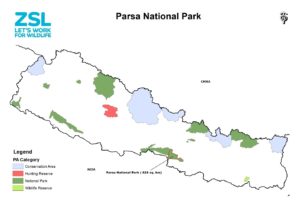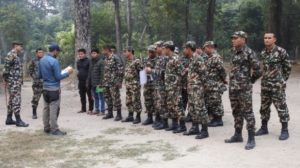 ZSL is monitoring tigers in Nepal across the Chitwan/Parsa Complex, an important landscape for biodiversity containing not just tigers, but rhinos and elephants too. This lowland area along the Nepal border with India, is a key recovery site for Bengal tigers. The long term aim is to provide a stronghold for tigers to repopulate the Terai landscape. Nepal is one of the few countries that are so far on track to reach the target of doubling its tiger numbers by 2022.
ZSL is monitoring tigers in Nepal across the Chitwan/Parsa Complex, an important landscape for biodiversity containing not just tigers, but rhinos and elephants too. This lowland area along the Nepal border with India, is a key recovery site for Bengal tigers. The long term aim is to provide a stronghold for tigers to repopulate the Terai landscape. Nepal is one of the few countries that are so far on track to reach the target of doubling its tiger numbers by 2022.
The end of year report gives results of camera trap monitoring which was part of the government’s National Tiger and Prey Base Survey. This included surveys in all the tiger bearing areas of Nepal including Protected Areas, corridors and others. In Parsa and its extension area where this project has its focus, 14 teams with more than 110 people were deployed from 12 camp locations to cover 274 grids. Results from here showed 18 tigers using this landscape.
 SMART patrolling to monitor the law enforcement activities was implemented from three guard posts in the extension area. 107 patrol members including both army and park staff were trained over two sessions. The training was principally focused on the basics of SMART, a tool to record patrol activities and site-level law enforcement monitoring following the legal aspects and values of national parks and wildlife conservation.
SMART patrolling to monitor the law enforcement activities was implemented from three guard posts in the extension area. 107 patrol members including both army and park staff were trained over two sessions. The training was principally focused on the basics of SMART, a tool to record patrol activities and site-level law enforcement monitoring following the legal aspects and values of national parks and wildlife conservation.
To streamline the collection of data by the patrols, an android based hand-held collection device was trialled using the software CyberTracker. It was targeted to frontline staff (Nepal army and PNP staff) who patrol daily in the extension area of PNP, and who are responsible for day-to-day site-based conservation activities.
Key results from the project
Tiger and prey-based monitoring in the extension area of PNP, completed as part of a national tiger and prey-based survey. Both financial and technical support was provided to GoN to conduct the survey. This resulted in an estimated tiger population of 18 in PNP and adjoining forests.
- An occupancy survey east of the extension area up to Bagmati river, across the TAL area was completed to monitor potential tiger movement as part of a national tiger and prey-based survey and tiger signs were detected in 2 out of 11 grids towards the east of the extension area of PNP, up to Bagmati River across TAL area. This indicates the potential of this area to facilitate tiger movement, and the importance of working with communities in this area to ensure high habitat quality and protect wildlife from hunting.
- Two refresher training sessions planned under this project were completed. In total, 107 staff members including from both the park and Nepal army, of 3 guard posts, were trained in paper-based SMART techniques; 65 army and park staff members were trained on the use of CyberTracker for SMART data collection. Also, for its effective implementation, equipment and logistical support was provided to the park to continue law enforcement patrols in the extension area.
- There was more than a 4-fold increase in patrol numbers carried out by 3 guard posts, compared to that of previous years in the extension area. Massive increases in patrol efforts compared to previous years, and the number of wildlife observations (including tiger and prey-based species) have been recorded.
You can read the whole project report here.

